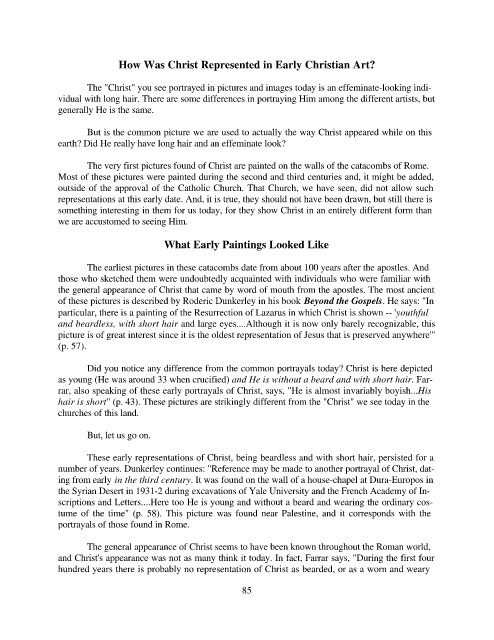Page 85 - BV6
P. 85
How Was Christ Represented in Early Christian Art?
The "Christ" you see portrayed in pictures and images today is an effeminate-looking indi-
vidual with long hair. There are some differences in portraying Him among the different artists, but
generally He is the same.
But is the common picture we are used to actually the way Christ appeared while on this
earth? Did He really have long hair and an effeminate look?
The very first pictures found of Christ are painted on the walls of the catacombs of Rome.
Most of these pictures were painted during the second and third centuries and, it might be added,
outside of the approval of the Catholic Church. That Church, we have seen, did not allow such
representations at this early date. And, it is true, they should not have been drawn, but still there is
something interesting in them for us today, for they show Christ in an entirely different form than
we are accustomed to seeing Him.
What Early Paintings Looked Like
The earliest pictures in these catacombs date from about 100 years after the apostles. And
those who sketched them were undoubtedly acquainted with individuals who were familiar with
the general appearance of Christ that came by word of mouth from the apostles. The most ancient
of these pictures is described by Roderic Dunkerley in his book Beyond the Gospels. He says: "In
particular, there is a painting of the Resurrection of Lazarus in which Christ is shown -- 'youthful
and beardless, with short hair and large eyes....Although it is now only barely recognizable, this
picture is of great interest since it is the oldest representation of Jesus that is preserved anywhere'"
(p. 57).
Did you notice any difference from the common portrayals today? Christ is here depicted
as young (He was around 33 when crucified) and He is without a beard and with short hair. Far-
rar, also speaking of these early portrayals of Christ, says, "He is almost invariably boyish...His
hair is short" (p. 43). These pictures are strikingly different from the "Christ" we see today in the
churches of this land.
But, let us go on.
These early representations of Christ, being beardless and with short hair, persisted for a
number of years. Dunkerley continues: "Reference may be made to another portrayal of Christ, dat-
ing from early in the third century. It was found on the wall of a house-chapel at Dura-Europos in
the Syrian Desert in 1931-2 during excavations of Yale University and the French Academy of In-
scriptions and Letters....Here too He is young and without a beard and wearing the ordinary cos-
tume of the time" (p. 58). This picture was found near Palestine, and it corresponds with the
portrayals of those found in Rome.
The general appearance of Christ seems to have been known throughout the Roman world,
and Christ's appearance was not as many think it today. In fact, Farrar says, "During the first four
hundred years there is probably no representation of Christ as bearded, or as a worn and weary
85


